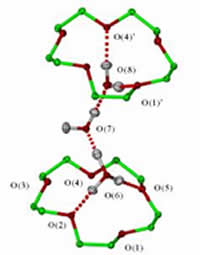Crystallography

Overview

Durham University has a large number of world leading scientists using structural techniques to understand the physics and chemistry of solids and is rapidly developing a biophysical capability. It is a major user of national and international synchrotron and neutron facilities. In 2007 these staff formed the Durham X-ray Centre (XRDur), a University approved Research Centre. With 41 staff drawn from eight Departments it is the largest Research Centre in the University and is larger than many Departments at Durham. Please see the X-ray service web pages and powder group pages for details of the facilities located within the Chemistry Department. The Supramolecular Chemistry group are major users of X-ray and neutron structural techniques, particularly in the characterisation of guest binding modes, solid forms and intermolecular interactions.
As part of our work students have the opportunity of taking part in visits to facilities at the ILL in Grenoble, France or the ISIS facility in the UK. Our single crystal neutron structure of the exotic H7O3+ ion trapped by two molecules called ‘crown ethers’ is shown right.1 We are particularly interested in low symmetry crystal structures with more than one molecule in the asymmetric unit2 and we maintain a dedicated web resource on this work (http://www.dur.ac.uk/zprime). We are also interested in crystalline hydrates and have setup a database of pharmaceutical hydrates called Hydrateweb.
- M. Calleja, S. A. Mason, P. D. Prince, J. W. Steed and C. Wilkinson, “Single crystal neutron and X-ray diffraction studies of (H7O3+)[AuCl4].15-crown-5″, New J. Chem., 2001, 25, 1475.
- J. W. Steed, “Should solid-state molecular packing have to obey the rules of crystallographic symmetry?” CrystEngComm, 2003, 5, 169.
Consultancy and Expert Witness
Prof. Steed undertakes a range of expert witness and consultancy work mainly in the area of intellectual property of pharmacuetical compounds, He has worked with a number of prominent law firms in the US, Canada and the UK testifying on matters such as:
- Solid state chemistry and polymorphic behaviour
- Single Crystal and Powder X-ray diffraction
- Thermal analysis (melting point, DSC, TGA)
- IR and NMR spectroscopy
- Organic and coordination chemistry
Please contact Professor Steed directly to discuss your requirements.
Collaborations and Service Work
The Diffraction group undertakes a number of Industrial Collaborations including:
- Low temperature (-173 °C) data collection
- Handling of small crystals
- Handling of sensitive crystals, including those prone to desolvation
- Crystal growing attempted(!)
- Absolute configuration (compounds containing heavy atoms such as S, P, metals)
Please contact the service manager to discuss your requirements.
Software
The free software X-Seed (by Prof. L. J. Barbour) is available from Prof. Barbour’s web site. X-Seed is an extremely useful graphical front end for the SHELX suite. If you work in crystal engineering or just need to display more than a single asymmetric unit, you need XSeed!






